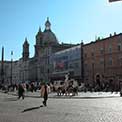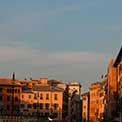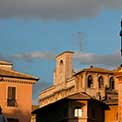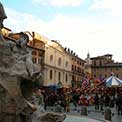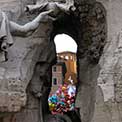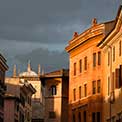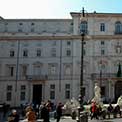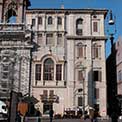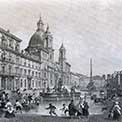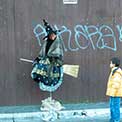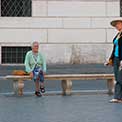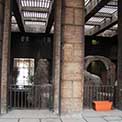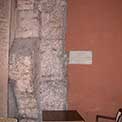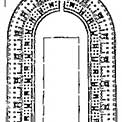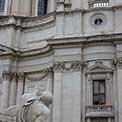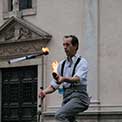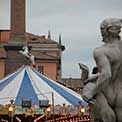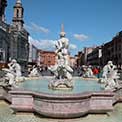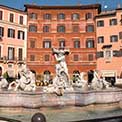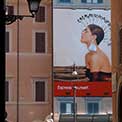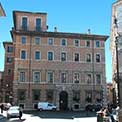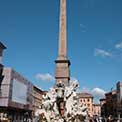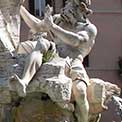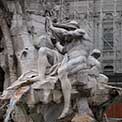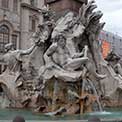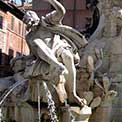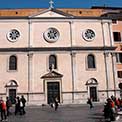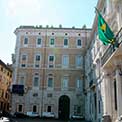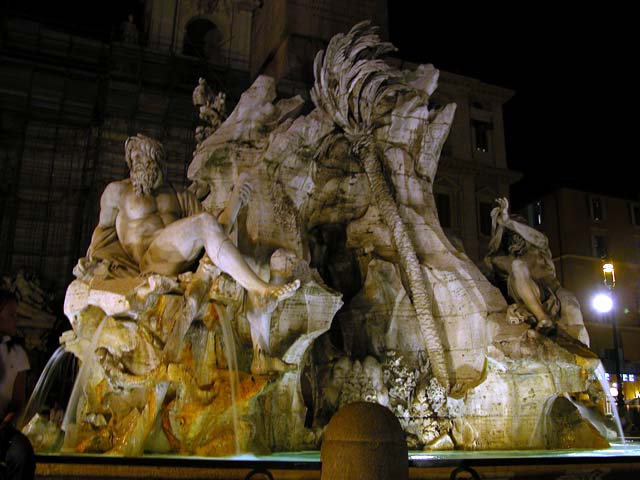
On this large square anciently stood the famous Agonal circus near the baths of Alexander Severus. The form of the circus has been preserved in building the houses. It was called Agonal on account of the games celebrated here, in honour of Janus; and from the Greek word Agon, which signifies combat. It is now named Navona, because it is somewhat in the form of a large ship. It is one of the largest and finest squares in Rome. Gregory XIII. adorned it with two fountains; one is placed towards St. Apollinaires, the other is opposite the church of St. James of Spain; it is composed of two large marble Basins, and adorned with statues; in the middle is a triton holding a dolphin by the tail, sculptured by Cav. Bernini; on the edge of the basin are four heads, and as many tritons, spouting water from their mouths; they were made by Flaminio Vacca, Leonardo da Sarzano, Silla Milanese, and Thaddeus Landini.
A market for provisions and various merchandises ie held in this square every Wednesday.
This place overflows every Saturday and Sunday during the month of August, forming a kind of lake ; the people assemble in crowds, both in carriages and on foot, to divert and refresh themselves, the. heat at this time being excessive.
A new Picture of Rome, and its Environs, in the form of an Itinerary - Mariano Vasi - 1819
This large piazza is corruptly called Navona, in place of Agonale. Here was the magnificent Circus Agonale, derived, as is supposed, from the word agone? which from the Greeks came to be applied to spesiacles of various games. Others, however, are of opinion, that the name is derived from the agonalian feasts by Numa: Pompilius dedicated to Janus, and celebrated on the 9th of January. It was also called the Circus of Severus, from his baths which were in its vicinity. Beside games, of pleasure and exercise, here were the lupanari, that is, subterranean rooms for common women; but now the spot is occupied by a large square, filled with noble houfes and churches, and adorned with three fine fountains. It is called Piazza Navona, perhaps from iti form refembling that of a large ship. Here every week a market is held for- the sale of the necessaries of life and domestic utensils; and the gardeners every day bring here their vegetables and fruits. On the Sundays in Auguft it is filled with water for the amulement of the people.
An historical description of ancient and modern Rome - J. Salmon - 1800
In the Piazza Navona we may trace the exact form of the Circus Agonalis, supposed to have been built by the Emperor Alexander Severus. The modern name also may easily be traced , as a corruption from the ancient one. From Agonalis or in Agone it came to be called Nagona f as it is written by J. Laurus. From Nagona the transition to Navona is not difficult. It should be mentioned , however, that this etymology is ridiculed by Nardini. He informs us, that port of ihe Campus Martius was fenced off with wood for the games called Ecjuiria , and that Alexander Severus formed it into a regular Circus . Donati mentions a coin of that Emperor with a Circus on the reverse : and Nibby quotes two documents of the years 870 and ii43, in which the Circus Agonalis and Circus of Alexander are clearly identified with the Piazza Navona.
Description of the antiquities & other curiosities of Rome - Edward Burton - 1830
In the Piazza Navona are three fountains ; the centre one supports the obelisk brought from the Circus of Caracalla. It consists of a great mass of artificial rock, to which are chained four river gods—a truly Bernini idea! He has not placed them at rest, in the recumbent, meditative, classical posture of river gods, but fastened them in the most uneasy attitudes, and unnatural contortions; and in order to show proper contempt for the architecture of Borrommi, who built the front of St. Agnes's church, the two water deities on the side next it are made to throw up their eyes to it in the shrinking attitude of terror, as if expecting it to fall upon them. But the Church of St. Agnes stands where it did, and has no appearance of moving; so that the alarm of these huge creatures seems only ludicrous and cowardly. If they had held up their hands and eyes at its ugliness, I should have had some sympathy with them ; but of its stability there is, unfortunately, no reason to doubt. From each of these colossal river gods, springs his own dribbling stream. You see at once the source of the Nile, which some stupid people imagined had never yet been traced —and the Danube spouts out his mighty waters,'in force sufficient to fill a moderate-sized bucket. After a short course down the sides of the artificial rock, the four great rivers of the different quarters of the world are lost in the basin of the fountain, which represents the Ocean.
I forgot to mention that there is, besides, a cavern in the rock, in which a lion and a horse reside in the most amicable manner possible; though what they do there in the middle of the sea, 1 do not exactly comprehend. This fountain is contrived so as to overflow annually ; and during the burning heats of summer, for a few evenings in the month of August, it is the delight of the people of Rome to drive about among its waters, which fill the Piazza Navona. It was suggested by an ingenious friend of mine, that this custom was probably the remains of the sports of the Naumachia, exhibited at the annual games in honour oi the gods, at this very period of the year, and in this very spot, which was the ancient Circus Agonalis.
Fountain of Fiumi - 1648-51
Innocent X., of the Pamfili family, afterwards erected the fine fountain in the middle of the square, from the designs of Cav. Bernini. It is formed of a large circular marble basin, seventythree feet in diameter, in the middle of which is a large rock pierced on the four sides; and in a sort of grotto are placed a sea horse on one side, and a lion on the other, both sculptured by Lazarus Morelli.
On the summit of. this rock, which is about forty-one feet high, is an obelisk of red granite, covered with hieroglyphics, fifty-one feet high; it was transported from Egypt to Rome, . by Carai alia, and placed in his circus, where it was found. At the sides of the rock are four colossal statues, made after the models of Cav. Bernini; they represent the four principal rivers in the world : the Ganges, holding-an oar, was sculptured by Mr. Adam, of Lorrain; the Nile, by Anthony Fancelli; the Plata, by Francis Baratta; and the Danube, which is the best, by Andrea, called the Lombard. These statues throw a vast quantity of water into the basin.
A new Picture of Rome, and its Environs, in the form of an Itinerary - Mariano Vasi - 1819
In the great fountain of Bernini in the Piazza Navona, is one 74 palms ( 54 feet ) high, which stands upon a rock, itself 60 ( 40 feet ). It was transported to this place from tlie Circus of Caracalla, about the year 1650. This is the Obelisk, upon which Kircher has written his long and learned Dissertation,divided into five books, and extending through 560 pages. It was published at Rome in 1650, and he gives to the Obelisk the title of Pamphylius, from Innocent X. who was of the Pamphilii family, and who had it transported to its present place. He conceives it to be one of the four, which Pliny, as already quoted, tells us, were erected by King Sothis in Heliopolis, each of which was 48 cubits high. He makes Caracalla to have transported it from Egypt in 249: but this must be mere conjecture; as it is not known for certain whether Caracalla was the buihler of the Circus in which the Obelisk stood. When Bernini removed it in 1649, at the order of Innocent X. it was broken into five parts, and lying on the ground.
Description of the antiquities & other curiosities of Rome - Edward Burton - 1830
Church of St. James of Spain
Church of NOSTRA SIGNORA DEL SACRO CUORE dal 1450
Church of S. GIACOMO DEGLI SPAGNUOLI,
This church was built in 1450, from the designs of Baccio Pintelli, by Don Alphonso Paradinas, bishop of Rodrigo in Spain. The marble head placed on the tomb near the 'door leading to the sacristy, is a fine sculpture, by Cav. Bernini: in the sacristy are two heads, by the same; one represents a beatified soul, the other a condemned one. The great altar-piece, representing our Saviour on the Cross, is by Sermoneta; the two side ones, are by Onuphrius d'Avellino. The statue of St. James, in the neighbouring chapel, is by Sansovino; the side paintings are by Pellegrino da Modena, pupil of Raphael. The picture in the next chapel is by Francis Preziado, a Spaniard. The St. Diego on the altar of the last chapel but one, and the side paintings, are by Annibal Caracci; the pictures above, and those on the outside of this chapel, are by Albano and Domenichino.
A new Picture of Rome, and its Environs, in the form of an Itinerary - Mariano Vasi - 1819
Braschi Palace - dal 1792
This magnificent palace was built towards the end of the last century, from the designs of Cavaliers Morelli and Morini. The staircase is very grand, and ornamented with fine marbles, columns, and pilasters of red oriental granite. In the first apartment is a very fine colossal statue of Antinoiis, found near Palestrina; a statue of Cincinnatus; of Julia Augusta, daughter of Drusus; a Diana; a Bacchus ; two large basins of antique red marble; and a sarcophagus, adorned with a basso relievo, representing a bacchanal; and some other ancient marbles. There are also several fine pictures.
A great part of this palace, stands on the Piazza di Pasquino, so called from an ancient statue, much damaged, which is placed on a pedestal at the angle of the Braschi palace; it took the name of Pasquin from a tailor who diverted himself with making satires, and jesting with those who passed his shop. After his death, this statue being found near his dwelling, was called by his name ; and from that time the Satirists affixed their writings on it, which has given rise to the word Pasquinade.
This ancient marble represents Menelaus supporting the body of Patroclus, killed by Hector. Although greatly damaged by time, yet from what remains connoisseurs suppose it to have been one of the finest statues in Rome.
A new Picture of Rome, and its Environs, in the form of an Itinerary - Mariano Vasi - 1819

